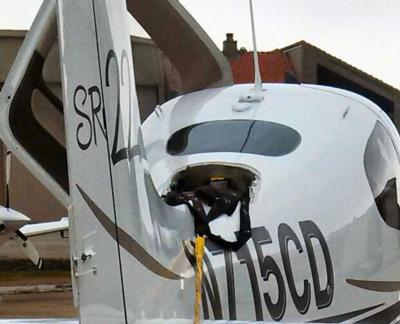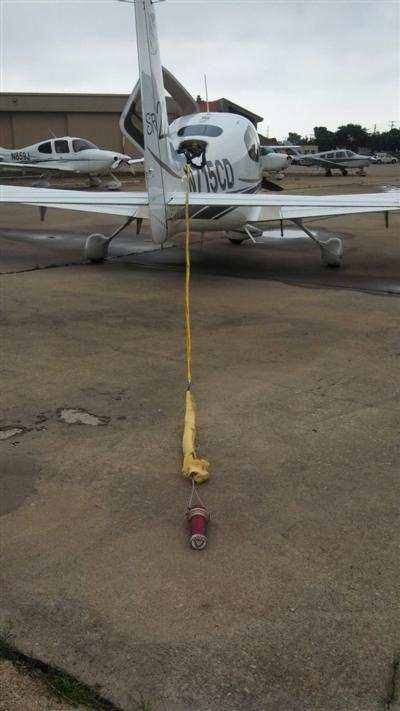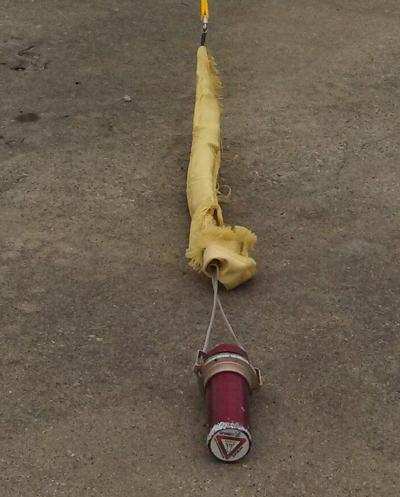A 2001 SR22, With A REPACKED CAPS Chute, Experiences Rocket Firing But NO Chute Deploy
You know you're having a bad day when a flight goes so bad that you feel you must resort to using a parachute to see you safely through the flight... but the day is TRULY bad when that chute fails and leaves you to battle the emergency that you thought you had escaped from.

Earlier Thursday, Cirrus Pilot Tim Valentine, flying near Addison Texas aboard N715CD, experienced some mode of instrument failure while IFR in a 12 year old Cirrus SR22, serial number 16. According to Valentine, who spoke to ANN extensively Thursday within hours of the incident, he was IFR from Addison TX to Kansas at 7000 feet when he noticed the first signs of some instrumentation issues while avoiding the back side of a major thunderstorm cell. Later, Valentine experienced more serious issues when the HSI went down, the autopilot followed and he began to suspect problems with his Attitude Indicator. The trend was not encouraging.
Realizing that he was in the soup, and that the situation seemed to be escalating -- and while flying an SR22 with an airframe parachute attached, Valentine elected to deploy the CAPS... a system that had been repacked the year before in accordance with the lifetime limits established by Cirrus when the system was developed based on technology pioneered by BRS over a decade before, starting with installations built for the Cessna 150 and 152 (for which ANN's Jim Campbell was one of the test pilots through a number of deployments).

Valentine described the non-deployment simply as, "I pulled the chute... heard the pop, smelled a burning smell, kept smelling the burning smell... and waited for the jerk of the chute deployment... which never came."
Realizing that he had the potential for a deteriorating instrument/guidance profile and not trusting his current situation, and after already having declared an emergency, he elected a steep dive (about 2800 fpm) through IMC until breaking out at or around 800 feet. Valentine kept ATC informed as he made his way back to Addison, and humorously noted that the turned down an offer to shoot the ILS back into ADS... which would have required him to ascend to over 2500 feet, and back into the clag, to be able to undertake. Valentine politely vetoed the option and elected to stay VFR at low altitude until landing at ADS.
As he taxied in, Valentine was notified that he "was dragging something" behind his plane as he taxied back to the local Cirrus Service Center. A few minutes, later, as his heart rate returned to something considered somewhat normal, Valentine noted that what we was dragging was the expended rocket canister, the two sections of bridle below it and that the entire parachute bag and assembly were still well-ensconced within the fuselage, though the fuselage hatch was long gone. Attempts by Valentine to dislodge the parachute were unsuccessful as he found the entire assembly "tightly wedged" within the aft fuselage.
At this point, the FAA has been on site for an initial look-see, and the NTSB is expected to investigate, as well. This is the first attempted deployment of a repacked CAPS assembly, and of course, the first failure of its kind. This repack was conducted fully under the control of the Cirrus Service Center program and the supervising parties at a time when Cirrus and BRS (the company primarily responsible for pioneering this technology -- despite Cirrus's attempts to suggest otherwise) were involved in legal problems arising from a number of IP and financial issues. These days, BRS has a much larger role in the repack process and in the prep of the systems that are upgraded at the time of repack.

Buzz among the Cirrus community has been extensive and a number of folks seeking more information from ANN, have indicated that their faith in the CAPS system has been shaken somewhat... and certainly in the repack process undertaken by Cirrus. One Cirrus owner noted that, "I'm sure as hell not going to tell my wife about this..."
The repack process, fairly expensive, requires the airplane to be down for a considerable period of time (especially for first generation Cirrus airframes), and is reportedly much more expensive than what was hoped for, by BRS, before Cirrus and BRS had their falling out (and, in fact, Valentine noted that when he started researching the repack process, he would have preferred that BRS undertake it... but, "Cirrus wouldn't allow it.") Regardless, Valentine loves his airplane and looks forward to fixing the damage done and getting a proper repack conducted at a later date.
ANN is monitoring the developing story and will provide more data as it becomes available.
 ANN's Daily Aero-Linx (05.06.25)
ANN's Daily Aero-Linx (05.06.25) ANN's Daily Aero-Term (05.06.25): Ultrahigh Frequency (UHF)
ANN's Daily Aero-Term (05.06.25): Ultrahigh Frequency (UHF) ANN FAQ: Q&A 101
ANN FAQ: Q&A 101 Classic Aero-TV: Virtual Reality Painting--PPG Leverages Technology for Training
Classic Aero-TV: Virtual Reality Painting--PPG Leverages Technology for Training Airborne 05.02.25: Joby Crewed Milestone, Diamond Club, Canadian Pilot Insurance
Airborne 05.02.25: Joby Crewed Milestone, Diamond Club, Canadian Pilot Insurance





